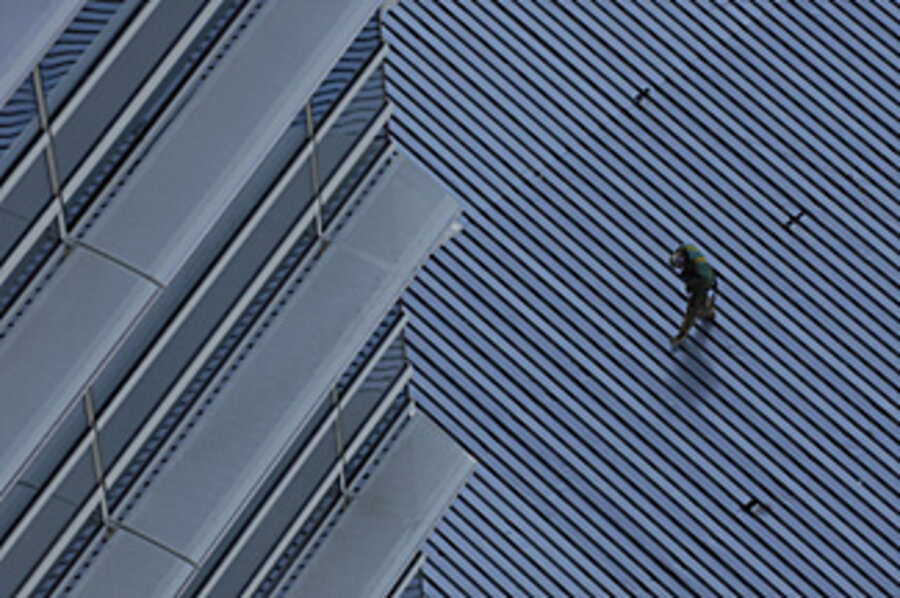San Francisco weighs green-building law
Loading...
| Oakland, Calif.
A proposed green building ordinance in San Francisco would transform the construction industry across northern California, impacting everything from city paint shops and local subcontractors to suburban neighborhoods resistant to sand pits and gravel quarries.
If passed in March, the ordinance would require most new commercial and residential high-rises to meet Leadership in Energy and Environmental Design (LEED) standards. Under LEED, developers must earn credits from a checklist of building practices that reduce the project's carbon footprint.
A number of cities and states, such as New Mexico and Washington, have adopted LEED for public buildings, but San Francisco would mandate it for the private sector as well. San Francisco officials say they want to get tough because the operation and construction of buildings account for half the city's CO2 footprint. If passed, the ordinance would be the most far-reaching in the US.
If it kicks off a national trend, it could realign the contours of the trillion-dollar construction industry. "The credits are absolutely driving the marketplace," says Marilyn Miller Farmer, a LEED architect in San Luis Obispo, Calif.
Take materials: There's been an explosion of new products including recycled carpet and insulation made from old blue jeans. The number of such products has jumped tenfold over the past decade, says Ms. Farmer, who tracks them at greenbuildingpages.com. "New products are coming out all the time," she says.
Other LEED credits stipulate that certain percentages of materials originate from within 500 miles of the site. That could make waves down at the docks, where ships are hauling in rocks and sand from Canada and cement from China. Local suppliers are short of these ingredients for concrete because Californians resist quarries and sand pits in their backyard.
LEED amplifies an argument made by local miners: Moving cement and rock halfway around the globe creates a lot of greenhouse gases. "Until LEED came along, there weren't credible environmental groups also saying this," says Ben Licari, director of geology and exploration at GraniteRock, a Watsonville, Calif., company that supplies locally sourced concrete. "Now customers come in the door ... specifically looking for green products and locally produced products."
California has been out front in LEED construction, with more than 1,000 buildings now registered with the nonprofit US Green Building Council. Many cities, including San Francisco, now offer incentives to private developers, the most powerful being fast-tracked permitting.
"Four years ago, when we were ...first making the business case for green buildings, I sat on a cross-country flight next to a very agnostic developer," says Christine Ervin, one of the original designers of LEED. "He was very ho-hum, rather blasé, about the whole thing, until I mentioned expedited permitting. And he said, 'That, little lady, would get my attention.' "
There are now fewer "agnostic" builders out there as costs for green building have fallen, savings from energy efficiency become ever more attractive, and research indicates green building helps attract workers and keep them productive.
"I've heard any number of developers say that if you're putting up a non-green building today, watch out, because you will have an obsolete product ... within just a couple of years," says Ms. Ervin.
Proposals such as San Francisco's suggest building owners have reason to worry about costly retrofitting. The plan affects new commercial buildings larger than 5,000 square feet, residential buildings over 75 feet in height, and renovations on buildings larger than 25,000 square feet. The standards gradually ratchet up, going from an immediate target of LEED Certified to a 2012 target of LEED Gold.
If enacted, the ordinance would create some winners and losers, say experts. One initial loss: jobs. So says the city's independent economic analysis unit in a review of an earlier – though similar – proposal. Over 20 years, the analysts project a loss of 265 to 2,476 jobs and between $66 million and $631 million in gross city product. That's because the higher cost of LEED Gold will discourage some construction spending.
The green premium, however, diminishes over time as demand drives down costs. Builders say that LEED's lowest rung, LEED Certified, is reaching cost parity with conventional building as green supplies and expertise grow commonplace.
On the other hand, green suppliers will be winners. One supplier already benefiting is Lewis Buchner. His business, Ecotimber in San Rafael, Calif., offers builders a compelling trifecta: His wood flooring has no urea formaldehyde, meets standards set by the Forest Stewardship Council (FSC), and in some markets, comes from within 500 miles. All three count toward separate LEED credits. He admits that the 500-mile credit can be difficult to supply. "We have a lot of angst about the fact that we've got maple flooring being made at a very good FSC factory in Asia, but we are shipping logs to Asia and back," he says. The environmental equations aren't simple. He notes that ocean shipment is more fuel efficient than trucking.
The 500-mile credit is an example of how LEED can single out one parameter in a complex environmental picture, says Arpad Horvath, professor of civil and environmental engineering at the University of California, Berkeley. "Trying to minimize our environmental impact in shipping might come at the cost of increasing some other environmental stressors," he says. "I think LEED and other policies ought to be thought of as a guidance that's inspiring further discussion."





